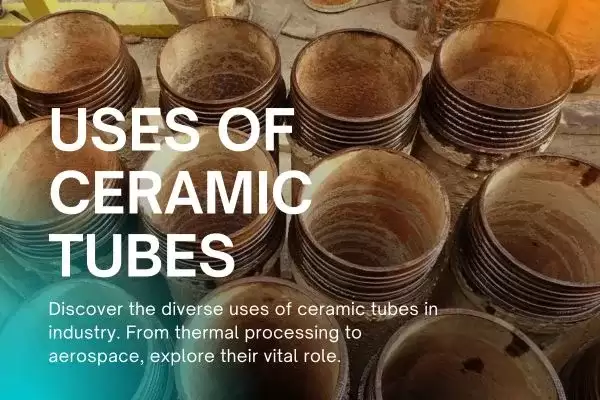
Sep 1,2023
In the ever-evolving world of industry and manufacturing, innovation is the key to staying ahead of the competition. One such innovation that has found its place in various sectors is ceramic tubes. These unassuming yet highly versatile components are crucial in various industrial applications. In this blog, we will delve into the fascinating world of ceramic tubes, exploring their diverse uses and shedding light on their significance.
Ceramic tubes are cylindrical structures crafted from ceramic materials, typically composed of aluminum oxide or zirconium oxide. These tubes stand out because of their exceptional resistance to high temperatures, corrosive environments, and electrical insulation properties. These attributes have opened up a world of possibilities in industries where extreme conditions are the norm.
One of the industry's primary uses of ceramic tubes is thermal processing. Whether in kilns, furnaces, or industrial ovens, ceramic tubes are employed to precisely contain and direct heat. Their ability to withstand extreme temperatures makes them indispensable in metalworking, ceramics, and glass manufacturing. Ceramic tubes create a controlled environment where materials can be heated, melted, or shaped without the risk of contamination or structural failure.
In temperature measurement, ceramic tubes play a crucial role as protectors for thermocouples. These devices are used to accurately gauge temperature in various processes. The ceramic tubes house the thermocouple wires, safeguarding them from harsh surroundings. This application is particularly vital in the chemical industry, where precise temperature monitoring is essential to ensure product quality and safety.
Ceramic tubes are also widely utilized as electric heater elements. Due to their exceptional electrical insulation properties, they are perfect for applications where electrical resistance heating is required. Industries that depend on these ceramic tubes include semiconductor manufacturing, plastics processing, and food production. They provide efficient and consistent heating, ensuring product quality and process efficiency.
In aggressive chemical environments, traditional materials often fail to hold up. This is where ceramic tubes shine. Their resistance to corrosion and chemical degradation makes them indispensable in chemical processing plants. They are used as reaction vessels, liners, and pipes, ensuring that even the most corrosive substances are contained and transported safely.
The semiconductor industry, known for its exacting demands, relies heavily on ceramic tubes. They are used in the production of silicon wafers and other critical components. The purity and stability of ceramic tubes are essential in this context, as contamination can lead to costly defects in semiconductor devices.
Ceramic tubes find their way into aerospace engineering as well. Ceramic tubes are used for heat shielding and as structural components in aircraft engines and space exploration, where extreme temperatures and harsh conditions prevail. Their lightweight nature and resilience make them a preferred choice in these high-stress environments.
Efforts to reduce environmental impact have led to the increased use of ceramic tubes in pollution control equipment. They are used in catalytic converters, supporting catalysts that help convert harmful emissions into less harmful substances. This application contributes significantly to cleaner air and reduces pollution levels.
Now that we've explored the multifaceted uses of ceramic tubes in various industries, it's essential to understand the role of ceramic tube wholesale suppliers in this ecosystem. These suppliers are the backbone of many businesses, providing a reliable source of high-quality ceramic tubes.
Ceramic tubes wholesale suppliers ensure a steady supply of these critical components to manufacturers, allowing them to focus on their core processes without worrying about material shortages or quality issues. Whether a small-scale operation or a large industrial facility, having a trusted ceramic tube wholesale supplier is invaluable.
To underscore the significance of ceramic tubes in industry, let's take a look at some recent statistics:
According to a market research report, the global ceramic tubes market is expected to grow at a CAGR of 6.8% from 2021 to 2028, driven by their increasing use in thermal and electrical applications.
The chemical industry, which relies heavily on ceramic tubes for corrosion resistance, is projected to grow significantly. The demand for these tubes in chemical processing is estimated to increase by 5.2% annually.
In the aerospace sector, the adoption of ceramic tubes is on the rise, with a projected annual growth rate of 7.1%. Their use in high-temperature applications is a key driver for this growth.
In conclusion, ceramic tubes may not always be in the spotlight, but their impact on various industries is undeniable. From withstanding scorching temperatures to resisting corrosive chemicals, these unassuming components are the unsung heroes of modern manufacturing. As industries continue to evolve, the demand for ceramic tubes is expected to soar, making ceramic tube wholesale suppliers invaluable partners in progress.